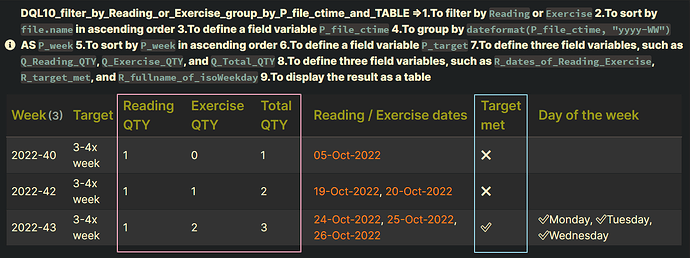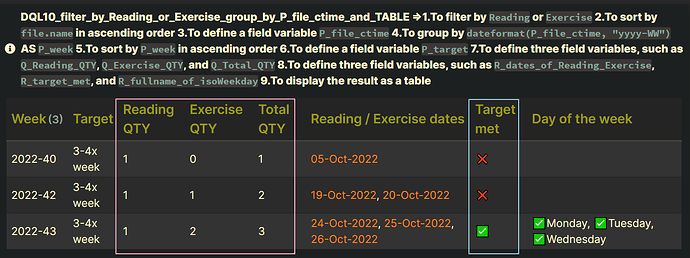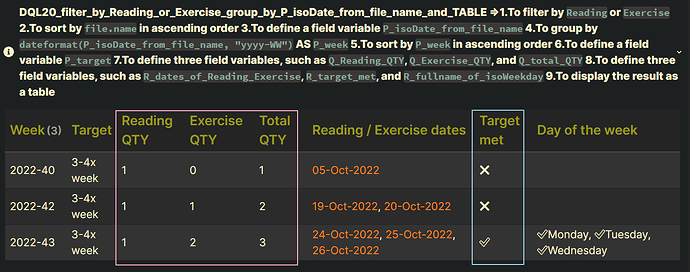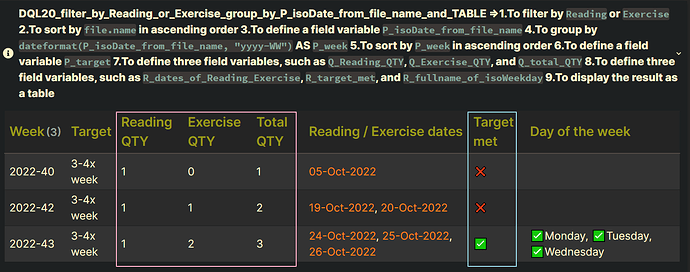Suppose that “on Monday” is corrected to “from Monday to Sunday per week”.
Topic : 1/2
Summary
- How to create a dataview table displaying the number of habits I’ve tracked per week? (P.S. Somehow have
 = 1 and
= 1 and  = 0 then get the sum) (
= 0 then get the sum) (DQL10,DQL20) - How to write a DVJS with the FLATTEN ideas step by step? (
DVJS10) - How to simplify the DVJS10, which is written with the FLATTEN ideas step by step? (
DVJS10_A1_11_shorter)
Test
Summary
- dataview: v0.5.55
Input
Summary
dictionary files:
- Location: “100_Project/02_dataview/Q26_ReadingExercise/Q26_test_data”
folder: 2022-40
- filename :
05-Oct-2022 - file.ctime: “2022-10-05T19:30:50”
---
# The creation date `cDate` of each daily note is correct.
cDate: 2022-10-05
---
Reading :: ✅
Exercise :: ❌
folder: 2022-42
- filename :
19-Oct-2022 - file.ctime: “2022-10-19T19:30:50”
---
# The creation date `cDate` of each daily note is correct.
cDate: 2022-10-19
---
Reading :: ❌
Exercise :: ✅
- filename :
20-Oct-2022 - file.ctime: “2022-10-20T19:30:50”
---
# The creation date `cDate` of each daily note is correct.
cDate: 2022-10-20
---
Reading :: ✅
Exercise :: ❌
folder: 2022-43
- filename :
24-Oct-2022 - file.ctime: “2022-10-24T19:30:50”
---
# The creation date `cDate` of each daily note is correct.
cDate: 2022-10-24
---
Reading :: ✅
Exercise :: ❌
- filename :
25-Oct-2022 - file.ctime: “2022-10-25T19:30:50”
---
# The creation date `cDate` of each daily note is correct.
cDate: 2022-10-25
---
Reading :: ❌
Exercise :: ✅
- filename :
26-Oct-2022 - file.ctime: “2022-10-26T19:30:50”
---
# The creation date `cDate` of each daily note is correct.
cDate: 2022-10-26
---
Reading :: ❌
Exercise :: ✅
folder: 2022-51_null_undefined
- filename :
21-Dec-2022 - file.ctime: “2022-12-21T19:30:50”
---
cDate: 2022-12-21
---
Reading ::
Exercise ::
- filename :
22-Dec-2022 - file.ctime: “2022-12-22T19:30:50”
---
cDate: 2022-12-22
---
Reading ::
- filename :
23-Dec-2022 - file.ctime: “2022-12-23T19:30:50”
---
cDate: 2022-12-23
---
Exercise ::
- filename :
24-Dec-2022 - file.ctime: “2022-12-24T19:30:50”
---
cDate: 2022-12-24
---
DQL10_filter_by_Reading_or_Exercise_group_by_P_file_ctime_and_TABLE :
NOTE: You always create daily notes on time. In other words, every file.ctime is correct.
Summary
Main DQL
| Code Name | Data type | Group By | Purposes | Remark |
|---|---|---|---|---|
| DQL10 _filter_by_Reading_or_Exercise _group_by_P_file_ctime _and_TABLE |
dateformat(rows.file.ctime, "yyyy-WW"):1.yyyy = four- to six- digit year, pads to 4 2.WW = ISO week number, padded to 2 dateformat(rows.file.ctime, "c"):ISO weekday (of the week), a string from “1”-“7” (“Monday” is “1”, “Sunday” is “7”) |
yes | 1.To filter by Reading or Exercise2.To sort by file.name in ascending order3.To define a field variable P_file_ctime4.To group by dateformat(P_file_ctime, "yyyy-WW") AS P_week5.To sort by P_week in ascending order6.To define a field variable P_target7.To define three field variables, such as Q_Reading_QTY, Q_Exercise_QTY, and Q_Total_QTY8.To define three field variables, such as R_dates_of_Reading_Exercise, R_target_met, and R_fullname_of_isoWeekday9.To display the result as a table |
P.S. You always create daily notes on time. In other words, every file.ctime is correct. |
Notes:
Summary
Q1: How to understand the meaning of the DQL10 in terms of the DVJS10?
Summary_Q1
A1_11:
Original Example: A1_11 (To be explained with simple Comments and corresponding DVJS10 statement)
```dataview
// T91. output pages: TABLE
// dv.table(
// [
// // P
// "Week",
// "Target",
//
// // Q
// "Reading QTY",
// "Exercise QTY",
// "Total QTY",
//
// // R
// "Reading / Exercise dates",
// "Target met",
// "Day of the week",
// ],
// groups.map((group) => [
// // P
// group.P_week,
// group.P_target,
//
// // Q
// group.Q_Reading_QTY,
// group.Q_Exercise_QTY,
// group.Q_total_QTY,
//
// // R
// group.R_dates_of_Reading_Exercise,
// group.R_target_met,
// group.R_fullname_of_isoWeekday,
// ])
// );
// #####################################################################
TABLE WITHOUT ID
// P
P_week AS "Week",
P_target AS "Target",
// Q
Q_Reading_QTY AS "Reading QTY",
Q_Exercise_QTY AS "Exercise QTY",
Q_total_QTY AS "Total QTY",
// R
R_dates_of_Reading_Exercise AS "Reading / Exercise dates",
R_target_met AS "Target met",
R_fullname_of_isoWeekday AS "Day of the week"
// T11. define pages: get pages from Sources
// let pages = dv.pages('"100_Project/02_dataview/Q26_ReadingExercise/Q26_test_data"');
// #####################################################################
FROM "100_Project/02_dataview/Q26_ReadingExercise/Q26_test_data"
// T13. filter by Reading or Exercise
// pages = pages.where((page) => page.Reading || page.Exercise);
// #####################################################################
WHERE Reading OR Exercise
// T15. sort by file.name
// pages = pages.sort((page) => page.file.name, "asc");
// #####################################################################
SORT file.name ASC
// ####
// # #
// # #
// ####
// #
// #
// #
// #
// T31. update pages: add a new field `P_file_ctime` into each page
// pages.forEach((page) => {
// page.P_file_ctime = page.file.ctime;
// });
// #####################################################################
FLATTEN file.ctime AS P_file_ctime
// T33. define groups: groupBy the pages + add a new field `P_week` into each group
// ***************************************************************** //
// T33_PART01: groupBy the pages
// let groups = pages.groupBy((page) => dv.func.dateformat(page.P_file_ctime, "yyyy-WW"));
// ***************************************************************** //
// T33_PART02: add a new field `P_week` into each group
// groups.forEach((group) => {
// group.P_week = group.key;
// });
// #####################################################################
GROUP BY dateformat(P_file_ctime, "yyyy-WW") AS P_week
// T35. sort groups: in ascending order
// groups = groups.sort((group) => group.P_week, "asc");
// #####################################################################
SORT P_week ASC
// T37. update groups: add a new field `P_target` into each group
// groups.forEach((group) => {
// group.P_target = "3-4x week";
// });
// #####################################################################
FLATTEN "3-4x week" AS P_target
// ###
// # #
// # #
// # #
// # #
// # # #
// ###
// #
// T41. update groups: add a new field `Q_Reading_QTY` into each group
// groups.forEach((group) => {
// group.Q_Reading_QTY = group.rows.Reading.filter((e) => (e === "✅")).length;
// });
// #####################################################################
FLATTEN length(filter(rows.Reading, (e) => e = "✅")) AS Q_Reading_QTY
// T43. update groups: add a new field `Q_Exercise_QTY` into each group
// groups.forEach((group) => {
// group.Q_Exercise_QTY = group.rows.Exercise.filter((e) => (e === "✅")).length;
// });
// #####################################################################
FLATTEN length(filter(rows.Exercise, (e) => e = "✅")) AS Q_Exercise_QTY
// T45. update groups: add a new field `Q_total_QTY` into each group
// groups.forEach((group) => {
// group.Q_total_QTY = group.Q_Reading_QTY + group.Q_Exercise_QTY;
// });
// #####################################################################
FLATTEN Q_Reading_QTY + Q_Exercise_QTY AS Q_total_QTY
// ####
// # #
// # #
// ####
// # #
// # #
// # #
// # #
// T51. update groups: add a new field `R_dates_of_Reading_Exercise` into each group
// groups.forEach((group) => {
// group.R_dates_of_Reading_Exercise = group.rows.file.link.join();
// });
// #####################################################################
FLATTEN join(rows.file.link) AS R_dates_of_Reading_Exercise
// T53. update groups: add a new field `R_target_met` into each group
// groups.forEach((group) => {
// group.R_target_met = dv.func.choice(group.Q_total_QTY >= 3, "✅", "❌");
// });
// #####################################################################
FLATTEN choice(Q_total_QTY >= 3, "✅", "❌") AS R_target_met
// T55. define h_isoWeekday_Fullname_of + update groups:
// add a new field `R_fullname_of_isoWeekday` into each group
// ***************************************************************** //
// T55_PART01: define h_isoWeekday_Fullname_of
// let h_isoWeekday_Fullname_of = {
// "1": "Monday",
// "2": "Tuesday",
// "3": "Wednesday",
// "4": "Thursday",
// "5": "Friday",
// "6": "Saturday",
// "7": "Sunday",
// };
// ***************************************************************** //
// T55_PART02: add a new field `R_fullname_of_isoWeekday` into each group
// groups.forEach((group) => {
// group.R_fullname_of_isoWeekday = dv.func.choice(
// group.Q_total_QTY < 3,
// "",
// dv.func.join(
// dv.func.dateformat(group.rows.P_file_ctime, "c").map(
// (e) =>
// "✅" + h_isoWeekday_fullname_of[e]
// )
// )
// );
// });
// #####################################################################
FLATTEN choice(Q_total_QTY < 3,
"",
join(
map(dateformat(rows.P_file_ctime, "c"),
(e) =>
"✅" +
{
"1": "Monday",
"2": "Tuesday",
"3": "Wednesday",
"4": "Thursday",
"5": "Friday",
"6": "Saturday",
"7": "Sunday"
}[e]
)
)
) AS R_fullname_of_isoWeekday
```
Code DQL10_filter_by_Reading_or_Exercise_group_by_P_file_ctime_and_TABLE
Summary_code
title: DQL10_filter_by_Reading_or_Exercise_group_by_P_file_ctime_and_TABLE =>1.To filter by `Reading` or `Exercise` 2.To sort by `file.name` in ascending order 3.To define a field variable `P_file_ctime` 4.To group by `dateformat(P_file_ctime, "yyyy-WW")` AS `P_week` 5.To sort by `P_week` in ascending order 6.To define a field variable `P_target` 7.To define three field variables, such as `Q_Reading_QTY`, `Q_Exercise_QTY`, and `Q_Total_QTY` 8.To define three field variables, such as `R_dates_of_Reading_Exercise`, `R_target_met`, and `R_fullname_of_isoWeekday` 9.To display the result as a table
collapse: close
icon:
color:
```dataview
TABLE WITHOUT ID
P_week AS "Week",
P_target AS "Target",
Q_Reading_QTY AS "Reading QTY",
Q_Exercise_QTY AS "Exercise QTY",
Q_total_QTY AS "Total QTY",
R_dates_of_Reading_Exercise AS "Reading / Exercise dates",
R_target_met AS "Target met",
R_fullname_of_isoWeekday AS "Day of the week"
FROM "100_Project/02_dataview/Q26_ReadingExercise/Q26_test_data"
WHERE Reading OR Exercise
SORT file.name ASC
FLATTEN file.ctime AS P_file_ctime
GROUP BY dateformat(P_file_ctime, "yyyy-WW") AS P_week
SORT P_week ASC
FLATTEN "3-4x week" AS P_target
FLATTEN length(filter(rows.Reading, (e) => e = "✅")) AS Q_Reading_QTY
FLATTEN length(filter(rows.Exercise, (e) => e = "✅")) AS Q_Exercise_QTY
FLATTEN Q_Reading_QTY + Q_Exercise_QTY AS Q_total_QTY
FLATTEN join(rows.file.link) AS R_dates_of_Reading_Exercise
FLATTEN choice(Q_total_QTY >= 3, "✅", "❌") AS R_target_met
FLATTEN choice(Q_total_QTY < 3,
"",
join(
map(dateformat(rows.P_file_ctime, "c"),
(e) =>
"✅" +
{
"1": "Monday",
"2": "Tuesday",
"3": "Wednesday",
"4": "Thursday",
"5": "Friday",
"6": "Saturday",
"7": "Sunday"
}[e]
)
)
) AS R_fullname_of_isoWeekday
```
Screenshots(DQL10): on win7
Screenshots(DQL10): on win10 or android
DQL20_filter_by_Reading_or_Exercise_group_by_P_isoDate_from_file_name_and_TABLE:
NOTE: Sometimes you create the daily notes later. In other words, not every file.ctime is correct.
Summary
Main DQL
| Code Name | Data type | Group By | Purposes | Remark |
|---|---|---|---|---|
| DQL20 _filter_by_Reading_or_Exercise _group_by_P_isoDate_from_file_name _and_TABLE |
file.name:1.“01-Jan-2022” 2.“01-Feb-2022” 12.“01-Dec-2022” dateformat(rows.file.ctime, "c"):ISO weekday (of the week), a string from “1”-“7” (“Monday” is “1”, “Sunday” is “7”) |
yes | 1.To filter by Reading or Exercise2.To sort by file.name in ascending order3.To define a field variable P_isoDate_from_file_name4.To group by dateformat(P_isoDate_from_file_name, "yyyy-WW") AS P_week5.To sort by P_week in ascending order6.To define a field variable P_target7.To define three field variables, such as Q_Reading_QTY, Q_Exercise_QTY, and Q_total_QTY8.To define three field variables, such as R_dates_of_Reading_Exercise, R_target_met, and R_fullname_of_isoWeekday9.To display the result as a table |
P.S. Sometimes you create the daily notes later. In other words, not every file.ctime is correct. |
Code DQL20_filter_by_Reading_or_Exercise_group_by_P_isoDate_from_file_name_and_TABLE
Summary_code
title: DQL20_filter_by_Reading_or_Exercise_group_by_P_isoDate_from_file_name_and_TABLE =>1.To filter by `Reading` or `Exercise` 2.To sort by `file.name` in ascending order 3.To define a field variable `P_isoDate_from_file_name` 4.To group by `dateformat(P_isoDate_from_file_name, "yyyy-WW")` AS `P_week` 5.To sort by `P_week` in ascending order 6.To define a field variable `P_target` 7.To define three field variables, such as `Q_Reading_QTY`, `Q_Exercise_QTY`, and `Q_total_QTY` 8.To define three field variables, such as `R_dates_of_Reading_Exercise`, `R_target_met`, and `R_fullname_of_isoWeekday` 9.To display the result as a table
collapse: close
icon:
color:
```dataview
TABLE WITHOUT ID
P_week AS "Week",
P_target AS "Target",
Q_Reading_QTY AS "Reading QTY",
Q_Exercise_QTY AS "Exercise QTY",
Q_total_QTY AS "Total QTY",
R_dates_of_Reading_Exercise AS "Reading / Exercise dates",
R_target_met AS "Target met",
R_fullname_of_isoWeekday AS "Day of the week"
FROM "100_Project/02_dataview/Q26_ReadingExercise/Q26_test_data"
WHERE Reading OR Exercise
SORT file.name ASC
FLATTEN split(file.name, "-")[2] AS yyyy
FLATTEN split(file.name, "-")[1] AS MMM
FLATTEN split(file.name, "-")[0] AS dd
FLATTEN
{
"Jan": "01",
"Feb": "02",
"Mar": "03",
"Apr": "04",
"May": "05",
"Jun": "06",
"Jul": "07",
"Aug": "08",
"Sep": "09",
"Oct": "10",
"Nov": "11",
"Dec": "12"
}[MMM] AS MM
FLATTEN yyyy + "-" + MM + "-" + dd AS s_isoDate
FLATTEN date(s_isoDate) AS P_isoDate_from_file_name
WHERE P_isoDate_from_file_name
GROUP BY dateformat(P_isoDate_from_file_name, "yyyy-WW") AS P_week
SORT P_week ASC
FLATTEN "3-4x week" AS P_target
FLATTEN length(filter(rows.Reading, (e) => e = "✅")) AS Q_Reading_QTY
FLATTEN length(filter(rows.Exercise, (e) => e = "✅")) AS Q_Exercise_QTY
FLATTEN Q_Reading_QTY + Q_Exercise_QTY AS Q_total_QTY
FLATTEN join(rows.file.link) AS R_dates_of_Reading_Exercise
FLATTEN choice(Q_total_QTY >= 3, "✅", "❌") AS R_target_met
FLATTEN choice(Q_total_QTY < 3,
"",
join(
map(dateformat(rows.P_isoDate_from_file_name, "c"),
(e) =>
"✅" +
{
"1": "Monday",
"2": "Tuesday",
"3": "Wednesday",
"4": "Thursday",
"5": "Friday",
"6": "Saturday",
"7": "Sunday"
}[e]
)
)
) AS R_fullname_of_isoWeekday
```
Screenshots(DQL20): on win7
Screenshots(DQL20): on win10 or android
Conclusion
Summary
CASE01: Every file.ctime is correct.
- Use the DQL10 if you always create daily notes on time. (In other words, every
file.ctimeis correct.)
CASE02: Every file.name is correct in the form, such as “01-Jan-2022”.
- Use the DQL20 if sometimes you create the daily notes later. (In other words, not every
file.ctimeis correct.)
CASE03: Every cDate is correct.
NOTE:
Suppose that everyfile.nameis correct in the different forms, such as “01-Jan-2022”, “01_Jan_2022”, “Jan 1, 2022”, “Jan/1/2022”, “January 1, 2022”, “31-03-2022”, “31_03_2022”, “03 31, 2022”, and so on.
- If sometimes you create the daily notes later and every
cDateis correct, use the DQL10 with modifyingfile.ctimetodate(cDate). - P.S. The field
cDateis defined in daily notes in the example.
folder: 2022-40
- filename :
05-Oct-2022 - file.ctime: “2022-10-05T19:30:50”
---
# The creation date `cDate` of each daily note is correct.
cDate: 2022-10-05
---
Reading :: ✅
Exercise :: ❌
Original Expression:
```dataview
FLATTEN file.ctime AS P_file_ctime
```
New Expression:
```dataview
FLATTEN date(cDate) AS P_file_ctime
```
Reference
Summary
Emojis
 White Heavy Check Mark Emoji (green tick, checkmark, checkbox, green check mark) : U+2705
White Heavy Check Mark Emoji (green tick, checkmark, checkbox, green check mark) : U+2705 Cross Mark Emoji (cross, x, ex, ex mark, multiplication sign) : U+274C
Cross Mark Emoji (cross, x, ex, ex mark, multiplication sign) : U+274C
The main DQL
- Q19_Workout: Solutions
The Regular Expression
- Q15_Reading: Solutions
JavaScript Objects
- Q20_Flags: S02: Solutions



